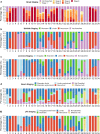Neuropathological consensus criteria for the evaluation of Lewy pathology in post-mortem brains: a multi-centre study
- PMID: 33399945
- PMCID: PMC7847437
- DOI: 10.1007/s00401-020-02255-2
Neuropathological consensus criteria for the evaluation of Lewy pathology in post-mortem brains: a multi-centre study
Abstract
Currently, the neuropathological diagnosis of Lewy body disease (LBD) may be stated according to several staging systems, which include the Braak Lewy body stages (Braak), the consensus criteria by McKeith and colleagues (McKeith), the modified McKeith system by Leverenz and colleagues (Leverenz), and the Unified Staging System by Beach and colleagues (Beach). All of these systems use semi-quantitative scoring (4- or 5-tier scales) of Lewy pathology (LP; i.e., Lewy bodies and Lewy neurites) in defined cortical and subcortical areas. While these systems are widely used, some suffer from low inter-rater reliability and/or an inability to unequivocally classify all cases with LP. To address these limitations, we devised a new system, the LP consensus criteria (LPC), which is based on the McKeith system, but applies a dichotomous approach for the scoring of LP (i.e., "absent" vs. "present") and includes amygdala-predominant and olfactory-only stages. α-Synuclein-stained slides from brainstem, limbic system, neocortex, and olfactory bulb from a total of 34 cases with LP provided by the Newcastle Brain Tissue Resource (NBTR) and the University of Pennsylvania brain bank (UPBB) were scanned and assessed by 16 raters, who provided diagnostic categories for each case according to Braak, McKeith, Leverenz, Beach, and LPC systems. In addition, using LP scores available from neuropathological reports of LP cases from UPBB (n = 202) and NBTR (n = 134), JT (UPBB) and JA (NBTR) assigned categories according to all staging systems to these cases. McKeith, Leverenz, and LPC systems reached good (Krippendorff's α ≈ 0.6), while both Braak and Beach systems had lower (Krippendorff's α ≈ 0.4) inter-rater reliability, respectively. Using the LPC system, all cases could be unequivocally classified by the majority of raters, which was also seen for 97.1% when the Beach system was used. However, a considerable proportion of cases could not be classified when using Leverenz (11.8%), McKeith (26.5%), or Braak (29.4%) systems. The category of neocortical LP according to the LPC system was associated with a 5.9 OR (p < 0.0001) of dementia in the 134 NBTR cases and a 3.14 OR (p = 0.0001) in the 202 UPBB cases. We established that the LPC system has good reproducibility and allows classification of all cases into distinct categories. We expect that it will be reliable and useful in routine diagnostic practice and, therefore, suggest that it should be the standard future approach for the basic post-mortem evaluation of LP.
Keywords: Diagnostic neuropathology; Lewy body disease.
Figures






References
Publication types
MeSH terms
Grants and funding
- P30 AG010124/AG/NIA NIH HHS/United States
- K24 AG053435/AG/NIA NIH HHS/United States
- U54 NS100717/NH/NIH HHS/United States
- MR/L016400/1/MRC_/Medical Research Council/United Kingdom
- G0502157/MRC_/Medical Research Council/United Kingdom
- MR/M024784/1/MRC_/Medical Research Council/United Kingdom
- P30AG10124/NH/NIH HHS/United States
- G0400074/MRC_/Medical Research Council/United Kingdom
- G0400074/UK MRC/International
- U19 AG062418/AG/NIA NIH HHS/United States
- MC_PC_18025/MRC_/Medical Research Council/United Kingdom
- K24AG053435/NH/NIH HHS/United States
- U54 NS100717/NS/NINDS NIH HHS/United States
- G1100540/MRC_/Medical Research Council/United Kingdom
- U19AG062418/NH/NIH HHS/United States
- MC_PC_14095/MRC_/Medical Research Council/United Kingdom
- G0900652/MRC_/Medical Research Council/United Kingdom
LinkOut - more resources
Full Text Sources
Other Literature Sources
Medical

